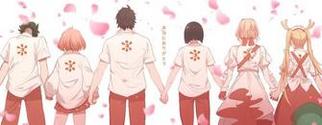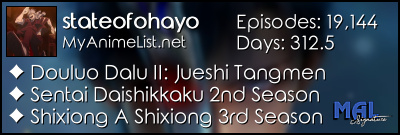ArbiterofWhim said:Episode 1 was very very solid. What stood out to me the most was the use of a large variety of shot composition techniques of a type and to a degree significantly beyond the norm in anime. Right off the bat we start with an extreme close up eye shot that flips to a POV low angle shot, which is maintained for the entirety of the opening scene. That's a bit of a bold move. Around 2:14 we cut from 1/2-1/2 split between close up and extreme long, to a close up of the subject of the extreme long shot while maintaining the same viewpoint and motion, which I really liked. Lots of nice complementary inverse shots like the static bird's eye shot of the spiral staircase at 2:44, followed by inverse of this at 2:50. Then there's the high angle balcony shot at 4:28 followed by the low angle shot at 4:40, both of which use shallow focus to direct the viewer to the protagonists. There's a cool static dolly-shot-like composition of the Reunion soldier in the hallway at 8:30 that subverts the viewer's expectation of what happens next. A view of the exit at 9:05 that primes the viewer to feel uneasy and suspicious. All these shot composition decisions aren't just willy-nilly. They're being used deliberately, with purpose, and to great effect. Another example would be the sudden shift to dutch angles around 4:52 to highlight how the unexpected approach of Reunion footsteps and the possibility of imminent discovery has upended their previously smooth operation. This is ALSO paired with the transition from ambient noise to BGM with rising tension. The framing, the establishing shots, the foreshadowing, everything about this episode just oozes style and I love it.
The director seems to have a real fondness for wide shots, use of negative space, and extended shot duration, so I looked up who it was out of curiosity. Turns out it's Watanabe Yuuki, which kinda surprised me. They haven't done a ton of directing, and of the anime I've seen where they were acting as animation director (New Game!, Plastic Memories, Mikakunin de Shinkoukei, etc.), it was all pretty standard anime shot composition. I wonder if these were stylistic choices motivated by the scale and architecture of the setting, the overall feel the creators want for the show, or if it's indicative of the director developing a personal style. After all, this is the first time they're being listed as "Director" of an anime rather than just an Animation Director for specific episodes. Honestly, I hope that all three reasons are true.
Setting aside my gushing over the visuals, there's a lot of other great stuff here. The Reunion forces were introduced and fleshed out fairly well. Aside from the rather large amount of exposition (though nothing out of the ordinary for a first episode with a lot to explain), there was a nice show-don't-tell around 16:39. One of the soldiers steps in to try and reign in another guy who's getting a bit too murder-happy. It's nice to see them reinforce that Reunion is a bad organization that's largely a victim of their circumstances, not just a cartoonishly evil band of incompetent street thugs. Amiya's Arts VFX/SFX are crisp and sick, really cool to look at. The use of proper 2d models for the large groups of Reunion soldiers (instead of the modern industry standard of 3DGC eldritch abominations) is refreshing. When 3D models are used (like the aerial drone at 19:46), it's well done. Damn, I'm back to talking about the visuals lmao.
I'm still tempering my expectations for the rest of the show, but even if it tanks that won't change how much I loved episode 1. And it's already leagues better than the level of quality I've come to expect from gacha adaptations (Azur Lane, Doll's Frontline, etc).





 on
on 
